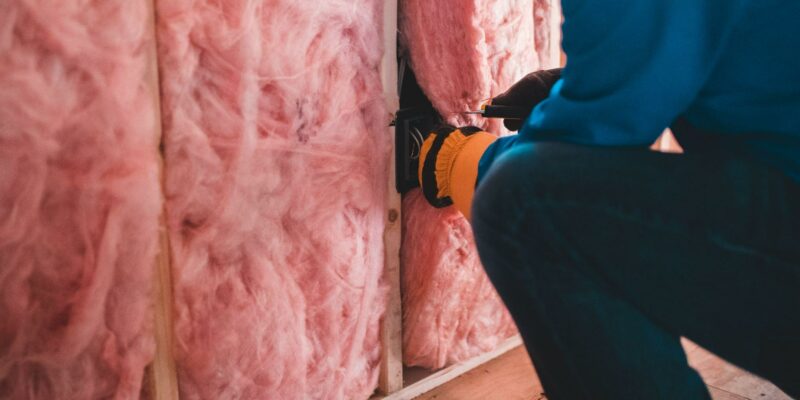Regardless of the season, every homeowner wants their home to be at a comfortable temperature. They don’t want it to be prohibitively expensive, so they require an energy-efficient house. The easiest method to accomplish this is to ensure that your home is adequately insulated.
Home insulation retains the temperature you want in your living areas for longer and less money, but it must be placed correctly. Various things may go wrong, and mistakes can be made during house insulation installation, just as they do with any home repair project. Knowing about these mistakes before insulating your home is the first step toward avoiding them.
If the insulation is not done correctly, serious problems like fire, mould and mildew growth, humidity, dampness, and structural concerns can occur. Knowing how to properly insulate your home is the key to success. Insulation is a skilled career, and mastering the skills takes time and effort.
However, if these typical blunders are avoided appropriately, you will have a well-regulated home with lower monthly energy expenditures.
The following are some frequent blunders that may turn an insulating installation into a massive nightmare for homeowners:
Insulation with Holes and Gaps
Most do-it-yourselves overlook the need to caulk every hole, crack, fissure, and gap. Whether from the basement or the attic, air leakage will render the provided insulation ineffective. Even a tiny opening or fracture can enable air to flow into the attic. It will waste energy and make your heating and cooling appliances work more than necessary to heat and chill your home.
When unskilled individuals attempt to install house insulation on their own, they frequently miss or entirely disregard these little gaps and holes. It’s a pity that the homeowner put so much work into installing insulation to lose advantage since he didn’t spot seal any air spaces before insulating.
How To Prevent Overlooking Minor Gaps and Holes
Sealing tiny gaps or fractures with foam insulation is preferable. Foam insulation from a spray can cover holes that are difficult to fill with other forms of insulating materials. The foam comes out of a narrow straw and expands rapidly, making the application simple. Even if you believe everything is in order, double-checking is nearly always good.
It’s also essential to use a staple gun to fasten batt insulation, ensuring the paper liner is correctly attached to the stud. Make sure the insulation touches the attic walls and flooring directly. When batt insulation is put sloppily, it loses its value, so be sure there are no gaps.
Using Insulation To Cover Ventilation
Vents allow fresh air to enter and depart the attic of every home. The continual airflow aids in moisture reduction and mould and mildew prevention. Attic vents are often positioned in the soffit or along the roof’s ridge.
When insulating an attic, homeowners often forget about the soffit vents and cover them with insulation. This obstructs airflow intended for ventilation and moisture reduction. Even if you aren’t installing extra insulation, be sure the present insulation isn’t obstructing any roof vents.
How To Avoid Covering Roof Vents with Insulation
Experienced, professional installers may frequently avoid blocking ventilation with insulation through careful installation. If you’re doing your insulation, acquire and install baffles, which are corrugated pieces of plastic positioned on your attic roof’s interior and allow vents to air.
Picking The Wrong Insulation Materials
Every home is unique, and each type of insulating material serves a specific purpose. Spray foam insulation may be perfect in one situation but entirely inappropriate in another. Let’s say you choose to insulate your basement using fiberglass insulation. Because basements are wet and fiberglass holds moisture, this combination will almost certainly cause you problems in the future.
When installing your insulation, experienced insulation contractors can advise you on the insulating material you need for each section of your home. If you try to insulate your home yourself, you run the danger of selecting an insulating material that is inappropriate for your home’s environment.
How To Prevent Picking the Wrong Insulation Materials
To prevent picking the inappropriate insulating material, make purchases from reputable suppliers like Croylek. Because climate plays an important role, make sure the advice you’re reading is appropriate for your climatic zone.
You must calculate the proper R-value of your insulation since this will direct you to the sort of material your home requires.
The R-value Misconception
Most homeowners are unfamiliar with the R-value calculating technique. Therefore they choose a low-R-value insulating material since it is less expensive. They are frequently unaware that the greater the rating, the more energy-efficient the insulation.
You will still have to deal with uncontrolled temperature and drafts if you use insulating material with a low R-value. For house insulation, saving money in the near term might cost homeowners a lot in the long run. However, installing the highest R-value attainable may not be essential because the benefits of a higher R-value are not linear.
How To Select the Right R-value Materials
Insulation contractors will understand and install insulation based on climatic zone and local building code requirements. They have the project experience to assess your house’s R-value and choose the optimum solution based on the size of your attic space and how much you are prepared to invest in a more energy-efficient home. While a greater R-value is preferable and provides more energy-efficient insulation, it also costs more; thus, a happy medium must be found when determining what insulation to invest in. Other insulation services that insulation contractors may do to help you save money on your energy costs include installing a radiant barrier in your attic.
Unnecessary Removal of Old Insulation
Another common blunder made by most DIYers is removing the existing house insulation. They assume that outdated insulation that seems drab and unclean is of little value. Although it is a valid assumption, it is not always essential to delete it. Even if it’s old and filthy, it’ll still work and save you money if you leave it in place and put more insulation on top of it./

Instead of beginning from scratch, it is advised that you assess the R-value of your current insulation and consider ways to increase it. When old insulation is put to new insulation, it acts as an extra blanket for your home, saving time and money on insulation removal. You will also waste time and material when blowing in the new insulation.
Aside from the state of the insulation, the age of your home is another factor to consider. If it was built in the 1980s or before, it might be essential to remove outdated insulation. It might, for example, include asbestos, which could pose a severe health risk to you and your family. If rats have seriously infested your home, existing insulation will be significantly polluted by their droppings, making it necessary to have it removed. Even if the wildlife problem in your attic is decades old, pathogens can survive in animal excrement for years, putting you in danger of contracting infections that have spread from your attic to your living area.
If you really have the need to change it, you can get some asbestos testing kit to at least put your mind at ease.
How To Check the Condition of Current Insulation
It’s not always the case that old insulation is worth maintaining. The following are important considerations:
- Examine the R-value of your current insulation.
- Check that the attic is dry and not damp or moldy.
- Check the insulation for any substantial animal droppings or excrement.
Decide whether to remove the insulation and start from scratch or add to the existing insulation after assessing these criteria.
Installing Home Insulation on Your Own
It is advisable to leave house insulation to a professional insulation firm like iFoam. For something as important as house insulation, DIY is incredible for lesser jobs, but you should think twice before taking on the challenge.
It’s important to remember that removing outdated insulation is a sensitive operation that requires homeowners to consider several essential variables. Large animal excrement, for example, should be handled with care. Removing huge animal excrement by hands, such as those of opossums and raccoons, to avoid any virus or bacterium particles being disturbed and drifting into the air, potentially contaminating the area. The technicians wear respirators to avoid inhaling any potential infections from tiny rodent excrement that hands can’t collect and must be sucked away.
Animal excrement is only one of the numerous contaminants homeowners should know about. Hazardous substances such as asbestos, mould, mildew, and polluted animal droppings are the last thing homeowners want to expose themselves and their loved ones.
Conclusion
One of the most effective strategies to reduce your energy expenditures is properly insulating your home. Being knowledgeable is critical. Insulation is a full-fledged craft, and mastering the skills takes time and effort. However, you may get off to a fantastic start by avoiding some of the most typical insulation project sabotage blunders.













Comments